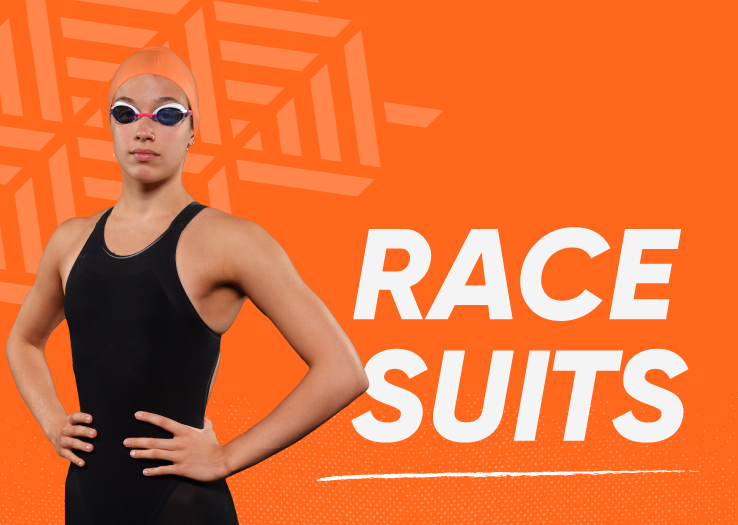Blog

Race Suits
Race suits are specifically designed for swimming competitions and are made from a specialised fabric that can help reduce skin drag through the water, increasing streamlining, and thus gaining a speed advantage. At Hamilton, most competitive swimmers will wear a race suit (racing briefs or knee suits) to every competition regardless of the age of the swimmer and the level of the meet. These suits are typically of the highest quality (tech suits) and the latest design. Often, our younger swimmers will arrive on competition days at 7 am already wearing their race suit and continue to wear the same suit throughout a day’s racing and home again at night. This blog aims to educate our athletes and parents on the information they need regarding which race suit to purchase, how to decide if you need one and when is an appropriate time to invest in such sporting technology.
The History
Starting around the year 2000, a big investment was made in the innovation of swimwear, taking ordinary swimsuits and swim briefs from purely practical attire to one of a performance-enhancing nature. To do this, engineers were entrusted with the job of making a racing suit that mimicked the skin of sea-based animals such as sharks. In the years following, swimsuits and briefs evolved rapidly into knee suits, leg-suits, and ultimately full-body suits where swimmers were covered in tight-fitting material from wrists to ankles. It didn’t take long before world records were tumbling, and the competition was focused on who was wearing what in each stroke and across both sexes. Considering the advancement of technology, FINA (now World Aquatics) was forced to intervene and introduce rules dictating the material and design of swimsuits to bring about a return to competitions that focussed on who was swimming the fastest as opposed to who had the most aid (and ultimately money to invest in the sport). Tech suits today are limited to knee-suits for females (open or closed back) and knee length briefs for males. All race suits must be approved by World Aquatics, otherwise swimmers risk disqualification.
How to choose a suit
In today’s climate, swimmers have an extensive range of race suits to choose from. The bigger brands such as Speedo and Arena dominate in all countries with brands such as FINIS, TYR, and Mizuno worn by swimmers who have perhaps been fortunate to try on the merchandise before buying rather than relying on what is familiar or popular amongst peers. It is important to note, that different brands are modeled on different body shapes based on where the brand was created and ultimately who they were designing the brand around. For example, Speedo is an Australian-founded company that modeled its initial suit design and measurements around Australian swimmers. In contrast, Arena is founded by an Italian who had an array of European athletes to model the initial suit design. Modern-day brands such as Mizuno have roots firmly in Japan and FINIS is an American brand originally centered around designing the monofin before branching out into swimwear. This may seem like irrelevant information, but brand origins typically dictate suit development in terms of hip size, torso length, and leg length, which is designed around the initial market. It is important to consider individual swimmer measurements and use brand-specific sizing charts to see what the best fit for your body is. Only then can a racing suit truly become like a second skin.
When to wear a suit
With all that has been said above, it may seem like wearing a racing suit is an absolute must in terms of performance outcome. As a former international swimmer, I truly believe this is not the case. There will never be a shortcut around working hard on technique, fitness, nutrition, psychology, etc. A racing suit will only ever provide marginal gains in performance by helping create less drag through the water (in a similar way wearing a swimming cap does). The general advice would be for swimmers over the age of 13 years to consider buying a technical racing suit. In many countries, those below this age are banned from competing in such suits! New suits should be worn only at peak performance meets such as summer target meets or perhaps the last short course meet of the season. For suits to be effective, they must be tight (almost uncomfortable so) and worn for the least amount of time possible. You will have seen female athletes at the Olympics immediately drop their straps from their shoulders post-race and male athletes loosen the waistband on their racing briefs. New suits should never be worn in warm-ups, cool-downs or for multiple races across a session or day. Save it for when you need those marginal gains at peak meets! Once a suit has been worn for on average 8 races, it can be considered an “old suit”. This is not to say it will not provide an aid to reduce drag and a psychological advantage compared to wearing a training suit, but once the shiny look you get underwater fades, so does the “new” suit status. These suits can be worn at in-season meets or in training sessions for older athletes (Elite and Youth Squad) for race-specific work.
How best to care for your suit
To get the most out of your suit, as soon as possible post-race it should be removed and rinsed in cold water to remove the chlorine. Leaving chlorine to dry into your suit allows the chemicals to break down the fabric and remove the water-resistant technology. Never wash your suit in the laundry and never leave your suit to dry in direct sunlight.
Hopefully, the above information will help you buy the right race suit for you and ensure that the next time you invest in your performance, you can make the most of that investment.

